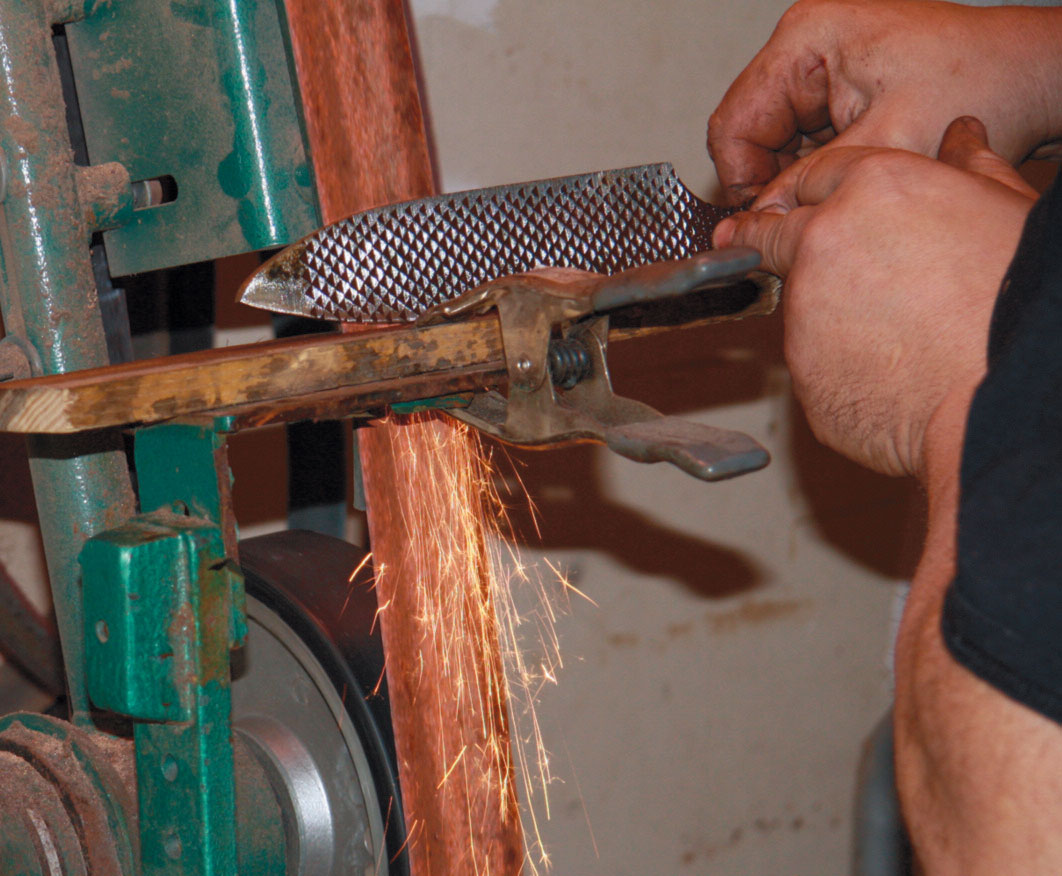Cape Cod Cutlery
The moment of inspiration for launching a business is quite often a very personal one. No one ever says, “I dunno, I guess I’ll try and make a better mousetrap.” It’s usually something more passionate like, “There’s got to be a better way!” as you’re standing atop a kitchen chair while the mice run amok beneath you. For Fred Carpenter and Tom Davenport, it all began with a simple desire: Tom wanted a knife. Having met and become fast friends through a shared love of medieval re-enactments, the two set about making Davenport’s wish a reality. Creating a knife that Davenport could wear to re-enactments actually produced something far bigger than one knife. It spawned Cape Cod Cutlery.
Word quickly spread through the ranks of medievalists, and soon Carpenter and Davenport were crafting knives for their first customers. In the four years since, the pair have evolved and expanded their knife line to modern hunting and fishing knives. They’re currently working on a new set of kitchen knives that chefs from some of the finest Cape Cod restaurants will “test drive” this winter. It’s the next step in the growth of this nascent Cape Cod business as they move towards offering something for the at-home chef: a three-knife set featuring a chef ’s knife, a paring knife and a filet knife.
One would be hard pressed to find two men more suited to being in business together. “I don’t mind production work. Tom has to be more creative,” Carpenter claims. As Davenport adds with a grin, “It always has to be something different.” Carpenter plays the role of realist while Davenport is willing to give anything a try. Davenport has actually gone on to make several versions of “his knife”. Inevitably, someone comes along, loves the look and feel of it and it’s sold…a good problem to have for sure.
All the knives are hand-made, so even though Carpenter and Davenport may consider the kitchen knives to be more of a production item, each will be a unique work of art. The process to produce such a gorgeous piece takes approximately 16 hours to complete. One crucial step is to heat treat the high carbon steel knives in the same Buffalo Forge that was used to form lengths of railroad track over 100 years ago. As Davenport says, “We may not have the newest tools, but we’ve got the coolest!” After quenching the steel in canola oil and several hours of tempering in a 400-degree oven (to provide more resiliency), the knives are ground down to the proper thickness and bevel. The durability of the blade is just as important as the sharpness of the cutting edge, which is razor sharp. Large hairless patches on each of their arms (often used to demonstrate the knives) attest to that.
The duo also likes to repurpose steel when possible by using old metal files. The steel of a file is high quality (to stand up to the task for which it was originally made), and partially grinding down the teeth leaves an interesting pattern on the knife. Decisions need to be made about the handle. What type of wood to use for it, or should it possibly be crafted from bone or synthetic antler? How about the bolster? It’s the leading edge of the handle and is oftentimes made from brass, but it could be stainless steel or nickel silver.
No knife would be complete without its own sheath, and Carpenter and Davenport custom-make form-fitting leather and wooden sheathes for each knife. The wooden versions are made from the same material as the handle of the blade, which gives it a truly impressive look. When the final sanding (with 5000-grit sandpaper!) is complete, Davenport’s favorite moment occurs. “When I rub oil on the handle after that final sand…that’s the wow moment,” he beams.
It has been a journey of self-education. As with most honed skills, trial and error is the method of study. “You hate to throw away a piece of steel you’ve been working on, but that’s one mistake you won’t make again,” Carpenter points out. Of course, they’re not completely alone in the knife-making wilderness. There are numerous sources available for advice and direction within the sizable knife-making community online. “Everyone’s so helpful when you have a question,” Davenport states. “It’s really amazing.” There is one line of questioning that falls on deaf ears and that’s pricing. “Somebody will ask, ‘how do you go about pricing your knives?’ and there’ll be no response,” Davenport chuckles. Some things are left to the individual knife maker to figure out on their own.
For now, Cape Cod Cutlery is a part-time venture for Carpenter, a soap maker for Summer House Soaps in Hyannis, and Davenport, a butcher and caterer. After a successful run at the farmers’ market at Cape Cod Beer this past summer and with an eye to other winter markets, their dream of turning the outfit into a full-time enterprise moves ever closer. Look for Cape Cod Cutlery’s display, along with Carpenter and Davenport, on Saturdays at Cape Cod Beer this winter. As always, the guys are happy to craft a custom knife for customers and specialize it to their individual needs. Simply reach out to them through their website capecodcutlery.com, and you can begin creating your very own knife, or maybe just buy Davenport’s. He’s sure to be working on yet another version of it right now.
Cape Cod Cutlery
capecodcutlery.com







